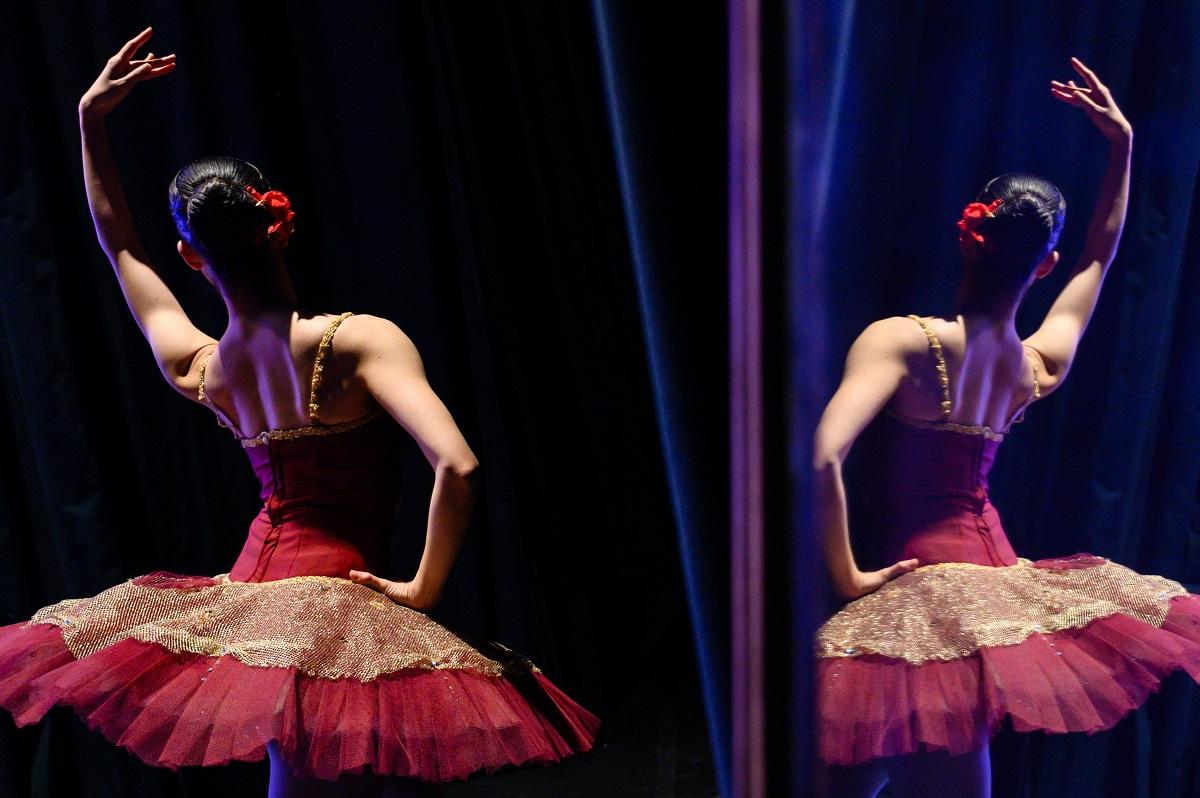
A dancer preparing for a performance at the Budapest Ballet Grand Prix in 2023. Some experts say that the ballerina’s lean frame is considered the current beauty ideal.
12:02 JST, October 2, 2024
The idealized look in the 1980s was muscular and toned (with leg warmers). That morphed into the skeletal “heroin chic” of the ’90s. More recently, a curvier physique with a big buttocks has dominated social media feeds. Is the return of slim the next women’s body trend?
In its annual report of yearly procedures for 2023, the American Society of Plastic Surgeons dubbed the new popular look the “ballet body.”
Fueled by the rise of the blockbuster GLP-1 drugs, including Ozempic and Wegovy, thinness appears to be making a comeback in the trend cycle. And some scholars, culture-watchers and health experts who have noticed the apparent shift are watching it with a wary eye – especially as cosmetic surgery and weight-loss drugs are available to only a specific segment of society with the right resources and access.
The reigning surgeries in the United States last year were liposuction, breast augmentation and the tummy tuck. And women displayed an increased preference for a smaller size of surgically sculpted breasts and buttocks, ASPS president Steven Williams said in an interview. The desired body of last decade – when the popularity of the Brazilian butt lift (BBL), which adds fat to the posterior, more than doubled – looked quite different.
“There really has been almost a decade of ‘more curves are better,’ and really glorifying those,” Williams said. “And now it seems like we’re taking a bit of an abrupt turn to something a little bit more slim.”
Phoebe Apeagyei, a senior lecturer of fashion technology and doctoral research lead at Manchester Metropolitan University, who has studied body image trends, said the ballet body was one that combined an idealization of thinness with a vogue for fitness that arose in the wake of the pandemic: a more sculpted version of the waif body popularized by British model Kate Moss three decades ago.
Kéra Nyemb-Diop, a nutrition scientist who focuses on healthy body image, has noticed the shift in her work with clients. Mainstream culture was in an era of “more acceptance, of body positivity,” she said. “And now, with the coming back of thinness, it feels like it’s going backward.”
The increased availability of new GLP-1 diabetes and weight-loss drugs, the most well-known of which is Ozempic, is probably a leading factor, Williams of the ASPS said. “There’s really nothing like that that has ever existed before,” he said, calling it a “transformational shift.”
Trends in body shapes – like in clothing and hair – inevitably change. And when trends hit the mainstream, the wealthy and chic seek to do something new. In other words, “people don’t want to look like their mom or their grandma,” Williams said.
“Women’s bodies in society are products, and like any products on the market, they have a cycle: from the beginning and then they become mature,” Nyemb-Diop said. “And I think the ‘BBL body’ was mature.”
“So the cycle was ready to bring in another body – and at the same time, Ozempic was there,” she said.
Rokeshia Renné Ashley, associate professor at Florida International University who studies body image and modification, said that it can be liberating and fun to exercise the power of choice over how one’s body looks.
She pointed out that, short of “going completely off the grid,” it was impossible for women to avoid the “looming stimuli” that pressured them to look a certain way, such as advertising, social media posts, and real-life comments. Dismissing women for participating in trends can be misguided and unproductive, and celebrations of both body positivity and body autonomy can “exist at one time,” she said.
“At this point in time, in 2024, we have access to so much, to see what our bodies could be, what they could look like, and how we can use them,” said Renné Ashley.
“We all have financial goals: you want to buy a house, you want to have a retirement fund,” she added. “Why can’t I have body goals – to change and augment my body? We are able to do whatever it is that we please – however, just go ahead and do it in a safe way.”
But there are fears that some women may attempt to achieve the “ballet body” using unhealthy means. Women who do not have the money, access, or desire for cosmetic surgery are still vulnerable to pressure to achieve the ideal body of the moment – particularly young women, Apeagyei cautioned.
Online posts have reflected anxieties about the trend. “The hip bone era destroyed me. i cannot believe its back,” one user wrote in a Reddit thread on the subject last year. “I dreaded this moment,” said another.
“The whole nutrition – and especially eating disorder – community is concerned,” Nyemb-Diop said. Studies have found a relationship between viewing repeated images of thinness and disordered eating, including anorexia and bulimia.
Body shapes have gone in and out of fashion for centuries: a deceptively superficial cycle that can hide a tangle of political, race, class and gender concerns.
Fashionable Victorians were thought to have imitated tuberculosis symptoms. Georgian England and France’s predatory fascination with an African woman, Saartjie (Sarah) Baartman, may have contributed to the craze for the bustle, the fake bottom of the 19th century, journalist Heather Radke documented in her 2022 book “Butts.”
The ’20s flapper with her boyish shape – coinciding with both a rebellion against dictates of acceptable female behavior and magazines advising extreme diets – preceded the bombshell hourglass figure pinned up by homesick GIs. Today, millions keep up with the Kardashians and their beauty practices.
In an interview, Radke said that sociopolitical currents inevitably influence fashion, but the impact can be clearer in hindsight than while a trend is unfolding.
And, she added, in the social media age of microtrends and individually tailored algorithms, the overwhelming dominance of any one trend has faded. Body positivity, fat acceptance and the ballet body can all exist simultaneously in different pockets of the internet. Different high-visibility fields can have different norms, such as fashion and Hollywood compared with pop music, which is arguably less stick-thin now than it has sometimes been.
“It’s not just Condé Nast and NBC telling us what’s beautiful,” Radke said. “There are other voices in the mix now, in an interesting way.”
The ballet body’s rise follows a period in which a look characterized by an ample behind – the appearance celebrated by Sir Mix-A-Lot’s “Baby Got Back” and Nicki Minaj’s 21st-century update “Anaconda” – dominated.
In a 2021 video about the “slim-thick” look that has been viewed almost 2 million times, cultural commentator Khadija Mbowe pointed out that the body type was more common in Black and Brown communities. It was taken to extremes that “aren’t typically found in nature” in the late aughts and 2010s by celebrities and influencers, often White, often with the unacknowledged help of surgery, she said.
Mbowe (who uses they/them pronouns) said in an interview that their views had evolved since making the video. “I struggle with associating one body type with a group of people, now,” they said.
“But it is frustrating,” they added, “when you see yourself and people that look like you get made fun of, or are not seen as beautiful, but then all of a sudden it’s on lighter, paler skin and it’s more attractive.”
Nyemb-Diop, too, criticized the “BBL body” era as one in which the features long associated with Black and Hispanic women were “really celebrated on White women, like the Kardashians” – though she added it was welcomed in part in some Black communities.
Mbowe said they weren’t surprised that the trend had changed to the ballet body.
They had noticed that trends were moving away from the “country club BBL,” a toned-down version of the 2010s buttock, to the leaner “Pilates body,” on social media and among friends.
And who knows what’s next?
A recent rise in “tenniscore” fashion – coinciding with the movie “Challengers” (2024), starring Zendaya – could lead to a desire for a tennis player’s body, they speculated.
“I have to tell myself – and I would tell anyone else – that this is fleeting,” Mbowe said. “And you can’t assume that somebody is happier than you or has a better life than you just because they fit within a trend.”
"News Services" POPULAR ARTICLE
-

American Playwright Jeremy O. Harris Arrested in Japan on Alleged Drug Smuggling
-

Japan’s Nikkei Stock Average as JGB Yields, Yen Rise on Rate-Hike Bets
-

Japan’s Nikkei Stock Average Licks Wounds after Selloff Sparked by BOJ Hike Bets (UPDATE 1)
-

Japanese Bond Yields Zoom, Stocks Slide as Rate Hike Looms
-

Japan’s Nikkei Stock Average Buoyed by Stable Yen; SoftBank’s Slide Caps Gains (UPDATE 1)
JN ACCESS RANKING
-

Keidanren Chairman Yoshinobu Tsutsui Visits Kashiwazaki-Kariwa Nuclear Power Plant; Inspects New Emergency Safety System
-

Imports of Rare Earths from China Facing Delays, May Be Caused by Deterioration of Japan-China Relations
-

University of Tokyo Professor Discusses Japanese Economic Security in Interview Ahead of Forum
-

Japan Pulls out of Vietnam Nuclear Project, Complicating Hanoi’s Power Plans
-

Govt Aims to Expand NISA Program Lineup, Abolish Age Restriction



























